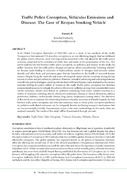| dc.description.abstract | In its Global Corruption Barometer of 2010/2011 and in a study of ten countries of the world, Transparency International (TI) describes corruption as an overwhelming tragedy that has infiltrated the global society. However, most worrying and unresearched is the role played by the traffic police in Kenya, purported to be custodians of traffic laws and order, in the perpetuation of the vice. This article explores; the link between traffic police corruption, air pollution, and disease. In this study, the author examines how the traffic police, through corruption, allows unroadworthy “smoking vehicles” on Kenyan roads leading to emissions of hydrocarbons, oxides of nitrogen, lead aerosols, carbon dioxide, and other toxic and poisonous gases that are hazardous to the health of innocent Kenyan citizens. Despite being the most efficient means of transport, motor vehicles constitute among the top sources of urban and peri-urban air pollution. However, instead of advancing and embracing emission control rules and technologies, smoking vehicles have infiltrated Kenyan roads unabated as the owners continue stuffing the police wallets to remain on the roads. Traffic police corruption has therefore compromised measures to mitigate the adverse effects of air pollution arising from uncontrolled motor vehicle emissions. Studies have linked air pollution emanating from motor vehicles emission to a variety of sicknesses including chronic obstructive pulmonary disease or chronic bronchitis, asthma, pneumonia, diabetes, cardiovascular disease, lung cancer, emphysema, among others. The objectives of this article are to examine: the relationship between vehicular emissions and health hazards; the link between traffic police corruption and vehicular emissions; ways in which police corruption and hence air pollution and related sicknesses can be mitigated, thereby facilitating transport mechanisms that are environmentally friendly. Documentary review is the main methodology in this study. Data was analyzed manually. The results of this study will be disseminated through journals. | en_US |
